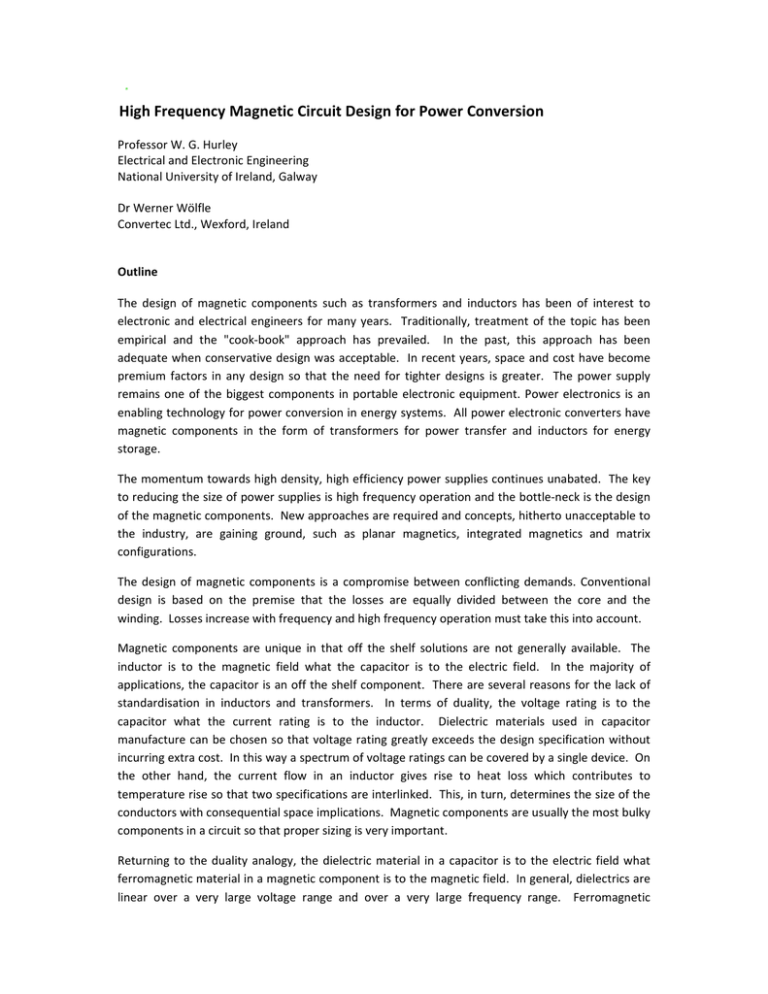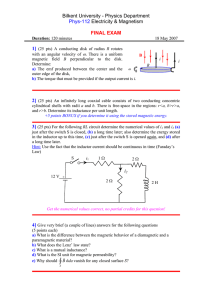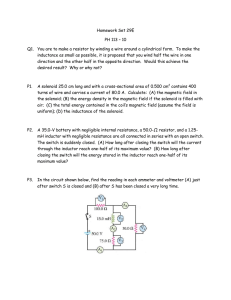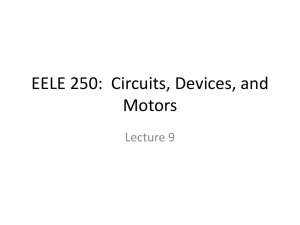High Frequency Magnetic Circuit Design for Power Conversion
advertisement

High Frequency Magnetic Circuit Design for Power Conversion Professor W. G. Hurley Electrical and Electronic Engineering National University of Ireland, Galway Dr Werner Wölfle Convertec Ltd., Wexford, Ireland Outline The design of magnetic components such as transformers and inductors has been of interest to electronic and electrical engineers for many years. Traditionally, treatment of the topic has been empirical and the "cook‐book" approach has prevailed. In the past, this approach has been adequate when conservative design was acceptable. In recent years, space and cost have become premium factors in any design so that the need for tighter designs is greater. The power supply remains one of the biggest components in portable electronic equipment. Power electronics is an enabling technology for power conversion in energy systems. All power electronic converters have magnetic components in the form of transformers for power transfer and inductors for energy storage. The momentum towards high density, high efficiency power supplies continues unabated. The key to reducing the size of power supplies is high frequency operation and the bottle‐neck is the design of the magnetic components. New approaches are required and concepts, hitherto unacceptable to the industry, are gaining ground, such as planar magnetics, integrated magnetics and matrix configurations. The design of magnetic components is a compromise between conflicting demands. Conventional design is based on the premise that the losses are equally divided between the core and the winding. Losses increase with frequency and high frequency operation must take this into account. Magnetic components are unique in that off the shelf solutions are not generally available. The inductor is to the magnetic field what the capacitor is to the electric field. In the majority of applications, the capacitor is an off the shelf component. There are several reasons for the lack of standardisation in inductors and transformers. In terms of duality, the voltage rating is to the capacitor what the current rating is to the inductor. Dielectric materials used in capacitor manufacture can be chosen so that voltage rating greatly exceeds the design specification without incurring extra cost. In this way a spectrum of voltage ratings can be covered by a single device. On the other hand, the current flow in an inductor gives rise to heat loss which contributes to temperature rise so that two specifications are interlinked. This, in turn, determines the size of the conductors with consequential space implications. Magnetic components are usually the most bulky components in a circuit so that proper sizing is very important. Returning to the duality analogy, the dielectric material in a capacitor is to the electric field what ferromagnetic material in a magnetic component is to the magnetic field. In general, dielectrics are linear over a very large voltage range and over a very large frequency range. Ferromagnetic materials are highly non‐linear and can be driven into saturation with small deviations from the design specifications. Furthermore, inductance is a frequency dependant phenomenon. Dielectric loss does not contribute to temperature rise in a critical way whereas magnetic core loss is a major source of temperature rise in an inductor. The totality of the above factors means that magnetic component design is both complex and unique to each application. Failure mechanisms in magnetic components are almost always due to excessive temperature rise which means that the design must be based on both electrical and thermal criteria. A good designer must have a sound knowledge of circuit analysis, electromagnetism and heat transfer. The purpose of this seminar is to review the fundamentals in all areas of importance to magnetic component design and to establish sound design rules which are straightforward to implement. The seminar is divided into four sections. The sequence of the sections was selected to guide the participant in a logical manner from the fundamentals of magnetics to advanced topics, covering the full spectrum of material by providing a comprehensive reference for researchers and practising engineers in transformer and inductor design. Introduction The Introduction covers the fundamental concepts of magnetic components that serve to underpin the later sections. It reviews the basic laws of electromagnetism as well as giving a historical context to the book. Self and mutual inductance are introduced and some important coil configurations are analysed, these configurations form the basis of the practical designs that will be studied later on. Section I ‐ Inductor Design In Section I, the design rules for inductor design are established and examples of different types of inductors are given. The single coil inductor, be it in air or with a ferromagnetic core or substrate, is the energy storage device for magnetic fields. A special example is the inductor in a flyback converter, since it has more than one coil. This treatment of the inductor leads to the transformer of Section II, which has multiple coils and its normal function is to transfer energy from one coil to another. Figure 1 Stored energy as a function of flux density and dissipation in an inductor Section II ‐ Transformer Design Section II deals with the general design methodology for transformers and many examples from rectifiers and switched mode power supplies are given. Particular emphasis is placed on modern circuits where non‐sinusoidal waveforms are encountered and power factor calculations for non‐ sinusoidal waveforms are covered. In a modern power converter, the transformer provides electrical isolation, it reduces component stresses where there is a large input/output conversion ratio and the operation of the transformer at high frequency reduces the overall size of the power supply. Figure 2 Winding, core, and total losses at different frequencies for optimization Figure 3 Flow chart for transformer design Section III ‐ High Frequency Design There is an inverse relationship between the size of a transformer and its frequency of operation. However, losses increase at high frequency. There is skin effect loss and proximity effect loss in the windings due to the non‐uniform distribution of the current in the conductors. The core loss increases due to the eddy currents circulating in the magnetic core and due to hysteresis. General rules are established for optimising the design of windings under various excitation and operating conditions, in particular, the type of waveforms encountered in switching circuits are treated in detail. A new approach to high frequency losses that avoid cumbersome Fourier analysis will be presented to optimise the winding design. This section will also cover fringing effects in gapped inductors. Figure 4 Plot of Reff/Rδ versus for various numbers of layers for a square wave of current Section IV ‐ Variable inductance The final section will take a detailed look at variable inductance and discuss topics that are particularly relevant to energy conversion systems. The powder iron core is used in high frequency applications and the inductance is normally found from the manufacturer’s data sheet. In solar photovoltaic (PV) systems, impedance matching between the output of the solar panels and the load for maximum power transfer is normally achieved by varying the duty cycle of a buck converter [2]. The minimum inductance required for continuous conduction in Maximum Power Point Tracking (MPPT) is a function of the solar radiation and therefore a variable inductance is perfectly suited to this application. Variable inductance also plays a role is power factor correction. Figure 5 Comparisons of CCM conditions in an MPPT dc/dc converter with a variable inductance Biographies William Gerard Hurley (M’77‐SM’90‐F’07) was born in Cork, Ireland. He received the B.E. degree in Electrical Engineering from the National University of Ireland, Cork in 1974, the M.S. degree in Electrical Engineering from the Massachusetts Institute of Technology, Cambridge MA, in 1976 and the PhD degree at the National University of Ireland, Galway in 1988. He was awarded the D.ENG degree by the National University of Ireland in 2011. He worked for Honeywell Controls in Canada from 1977 to 1979. He worked for Ontario Hydro from 1979 to 1983. He lectured in electronic engineering at the University of Limerick, Ireland from 1983 to 1991 and is currently professor of Electrical Engineering at the National University of Ireland, Galway. He is the Director of the Power Electronics Research Centre there. He served on the faculty at the Massachusetts Institute of Technology as a Visiting Professor of Electrical Engineering in 1997/1998. Prof. Hurley has given invited presentations on magnetics in Mexico, Japan, Singapore, Spain, Czech Republic, Hong Kong, China and USA. Research interests include high frequency magnetics, power quality, and renewable energy systems. He received a Best Paper Prize for the IEEE Transactions on Power Electronics in 2000. Prof. Hurley is a Fellow of the IEEE. He has served as a member of the Administrative Committee of the Power Electronics Society of the IEEE and was General Chair of the Power Electronics Specialists Conference in 2000. Werner Hugo Wölfle was born in Bad Schussenried, Germany. He graduated from the University of Stuttgart in Germany in 1981 as a Diplom‐Ingenieur in Electronics. He completed a PhD degree in Electrical Engineering at the National University of Ireland, Galway in 2003. He worked for Dornier Systems GmbH from 1982‐1985 as a Development Engineer for power converters in space craft applications. From 1986 to 1988 he worked as a Research and Development Manager for industrial AC and DC power. Since 1989 he is Managing Director of Convertec Ltd. in Ireland. Convertec develops high reliability power converters for industrial applications. He is currently an adjunct professor in Electrical Engineering at the National University of Ireland, Galway.




